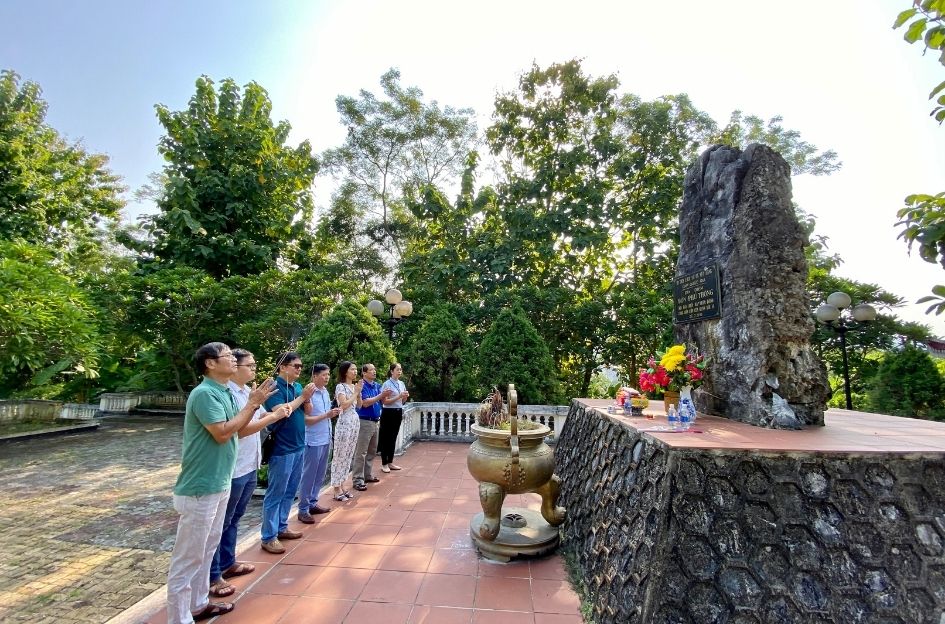NATU HISTORICAL MONUMENT, BACH THONG SUBURBAN DISTRICT
Na Tu historical monument located in Cam Giang commune, Bach Thong suburban district, next to highway No3 about 9km north of Bac Kan city. Where the young volunteer detachment 312 protected Na Cu bridge and Na Cu Phu Thong road.
On March 28 1951, on the way to Viet Bac, Ho Chi Minh visited inter-detachment 312 of young volunteers. After graciously asking and advising the members to overcome difficulties to complete their tasks, Ho Chi Minh gave the young volunteers unit 312 four lines of verse:
"Nothing is too difficult
Just fear of a doubting heart
Digging a mountain or filling the ocean
If we determine to do it, we'll succeed”
In 1996, Ministry of Culture Information(Ministry of Culture, Sports and Tourism now) recognised and ranked Na Tu monument as National historical monument. The monument was nicely embellished and there is also Uncle Ho's Memorial House on stilts; stele house, tents of young volunteers and auxiliary works.
Na Tu historical monument, Cam Giang commune was honoured to welcome many senior leaders of the Party and State, Youth Union's members from the whole country and tourists.
►
Learn more about Bac Kan Province : Vietnam's little-known gem
Phu Thong Military Post, 300m from Phu Thong three-way crossroads of highway 3 and the 258) is in Phu Thong town, Bach Thong Suburban District, 18 km north of Bac Kan city.

On October 1947, the French expeditionary force with nearly 1,200 troops parachuted to Bac Kan Town and occupied it, building a solid military post in Phu Thong in order to control and destroy our force.
Our force made three surprise attacks on the Phu Thong military post. These are our first military attacks and proved to be the rehearsals and lessons to smash the Dien Bien Phu entrenched fortification to defeat the French colonialists.
In 1996, the Ministry of Culture Information (Ministry of Culture, Sports and Tourism) recognised and ranked Phu Thong Military Post as a National historical monument.
SAFETY ZONE CHO DON
Safety zone Cho Don is located amongst the historical monuments of Viet Bac War Zone, where President Ho Chi Minh and central leaders were active during the war against the French colonialists(1946 1954).
During the prolonged war against the French colonialists, along with Dai Tu and Dinh Hoa Suburban Districts (Thai Nguyen), Son Duong, Chiem Hoa Cho Don (Thyen Quang), was a suburban district designated as safety zone for the war of resistance by the Party and Uncle Ho. The People of Cho Don Suburban District received and covered for the central agencies and senior leaders of the Party and State.
On December 8th, 1947, Ho Chi Minh went to Cho Don Suburban District to lead and direct the war of resistance. From December 7th, 1947 to the end of December 1947, Uncle Ho stayed and worked at Ca Village (Binh Trung commune). At the beginning of the year 1951, Uncle Ho stayed and worked at Na Pau (Luong Bang commune).
On August 1950, when the army prepared to open the border campaign, comrade Truong Chinh, together with the Party Central Committee office, moved from Phu Dinh (Thai Nguyen) to Khuoi Linh. While staying in Khuoi Linh, comrade Truong Chinh prepared for the second National Party member Congress (2/1951).
From early of 1950 to 1951, comrade Pham Van Dong (Deputy Prime Minister at that time) and government officers stayed and worked in Khau Ma Hill (Luong Bang commune).
From 1950 to 1952, Na Quan (Binh Trung commune) was designated as the Party Central conference room. There, took place the summary meeting of the autumn-winter border campaign in 1950.
During the period from 1947 to 1952, most of central agencies were located in Cho Don Suburban District such as VOV, Radio Authority, Military Technology Department, Politico- military school, Cuu Quoc newspaper print-shop, military medical surgical station, etc.
The Safety Zone Cho Don regroups with 6 national historical monuments (Ca Village, Na Pau, Khuoi Linh, Bang Village, Na Quan, Khau Ma Hill), 4 provincial historical monuments (Na Pay, Phja Tac, Khuoi Dam hill, Na Kien) and 16 other listed monuments are sites in which to learn about the history of our country.
Coming to Safety Zone Cho Don, besides visiting the historical and revolutionary monuments recording the magnanimous marks of our nation, tourists can explore traditional cultural beauties of the people here and witness the changes in this beloved and rich traditional area.
COONG TAT HISTORICAL MONUMENT, NGAN SON SUBURBAN DISTRICT
Coong Tat historical monument is in Duom Village, Thuong An commune, Ngan Son Suburban District, 30km northwest of the centre of Ngan Son Suburban District, and 90km north of Bac Kan city.
At this place, on September 22nd, 1943, under the direct leadership of comrade Vo Nguyen Giap, Chi Kien Cell was established, including 3 comrades: Duong Mac Hieu, Dong Van Bang, Doanh Thang Hy (Le Doanh Hang), and comrade Duong Mac Hieu was voted as secretary.
Chi Kien Cell was the first cell established in Bac Kan province that opened a new revolution era and period, marking the growth of revolutionary movements of Ngan Son Suburban District in particular and Bac Kan province in general. The Cell has led the people to revolt capturing Ngan Son station, disarm, seize the royal seal of violence force who was pro-French minions, allowing the establishment of the Provisional People's Committee in the communes, liberating Ngan Son Suburban District on June 1945, eventually liberating completely Bac Kan City and contributing to the victory of the August Revolution of 1945 of our nation.
The monument was recognsed and ranked as a provincial historical monument in 2002.
SaveSave